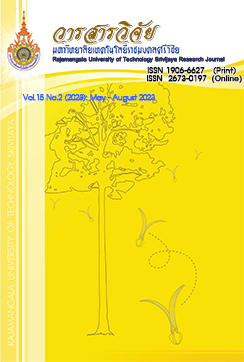Forecasting Model for the Amount of Water Flowing into the Reservoirs of the Electricity Generating Authority of Thailand (EGAT)
Keywords:
reservoir, decomposition, Holt-Winters' exponential smoothing, Box-Jenkins, combined forecastingAbstract
The objective of this study is to construct the appropriate forecasting model for the amount of water flowing into the 11 reservoirs of the Electricity Generating Authority of Thailand (EGAT), namely, Bhumibol Dam, Srinakarin Dam, Sirikit Dam, Vajiralongkorn Dam, Ratchaprapha Dam, Ubolratana Dam, Sirindhorn Dam, Chulabhorn Dam, Huai Kum Dam, Nampong Dam, and Bang Lang Dam. The forecasting models used in this study were decomposition method, Holt-Winters exponential smoothing method, Box-Jenkins method, and combined forecasting method. The amount of water flowing into the reservoirs was secondary data gathered from Electricity Generating Authority of Thailand during January 2010 to December 2020 (132 values). The data was divided into two sets. The training data set had 120 values, which were the data from January 2010 to December 2019, and were used for constructing the forecasting model. The test data set had 12 values, which were the data collected from January 2020 to December 2020, and were used for checking the accuracy of the forecasting models. The criterion of model evaluation was the lowest root mean square error (RMSE). Minitab 18 and Excel Office 365 were used as the data analysis program. Research results indicated that the combined forecasting method using weights based upon a regression analysis method had given the lowest RMSE.
References
Department of Alternative Energy Development and Efficiency. 2014. The dam is a reservoir of water energy. Available Source: https://
ienergyguru.com/2015/10/dam-and-hydro-electricity/, March 1, 2021. (in Thai)
Keerativibool, W. 2013. A Comparison of Forecasting Methods between Box-Jenkins, Simple Seasonal Exponential Smoothing, and Combined Forecasting Methods for Predicting Monthly Mean Temperature. Burapha Science Journal 18(2): 149-160. (in Thai)
Manmin, M. 2006. Time series and forecasting. Prakaypruek Publishing Center, Bangkok. (in Thai)
Minsan, P. 2022. Forecasting model for Export Condom Quantity of Thailand on the COVID-19 situation. The Journal of Applied Science 21(1): 244500. (in Thai)
Montgomery, D.C., Peck, E.A. and Vining, G.G. 2006. Introduction to Linear Regression Analysis. 4thed. Wiley, New York.
Papukdee, N., Senawong, N. and Busababodhin P. 2019. A Comparative Forecasting Model of Monthly Rainfall in the Northeast of Thailand. The Journal of King Mongkut's University of Technology North Bangkok 29(2): 302-313.
Sukparungsee, S. 2003. Using the Combined Forecasting Technique by Weighted Average. Journal of Technical Education Development 15(46): 1-7. (in Thai)
Taesombat, S. 2006. Quantitative Forecasting. Kasetsart University Press, Bangkok. (in Thai)
The Electricity Generating Authority of Thailand. 2020. Summary of the water situation and water management in EGAT reservoir in 2019. Available Source: http://water.egat.co.th/, May 30, 2021. (in Thai)
The Institute for the Promotion of Teaching Science and Technology. 2014. What have we gained and lost by building the dam. Available Source: http://primaryscience.ipst.ac.th/?p=257, March 1, 2021. (in Thai)
Weiss, C.E., Raviv, E. and Roetzer, G. 2018. Forecast Combinations in R using the ForecastComb Package. The R Journal 10(2): 262-281.
Downloads
Published
How to Cite
Issue
Section
License
Copyright (c) 2023 Rajamangala University of Technology Srivijaya Research Journal

This work is licensed under a Creative Commons Attribution-NonCommercial-NoDerivatives 4.0 International License.
The content and information in the article published in Journal of Rajamangala University of Technology Srivijaya It is the opinion and responsibility of the author of the article. The editorial journals do not need to agree. Or share any responsibility.







